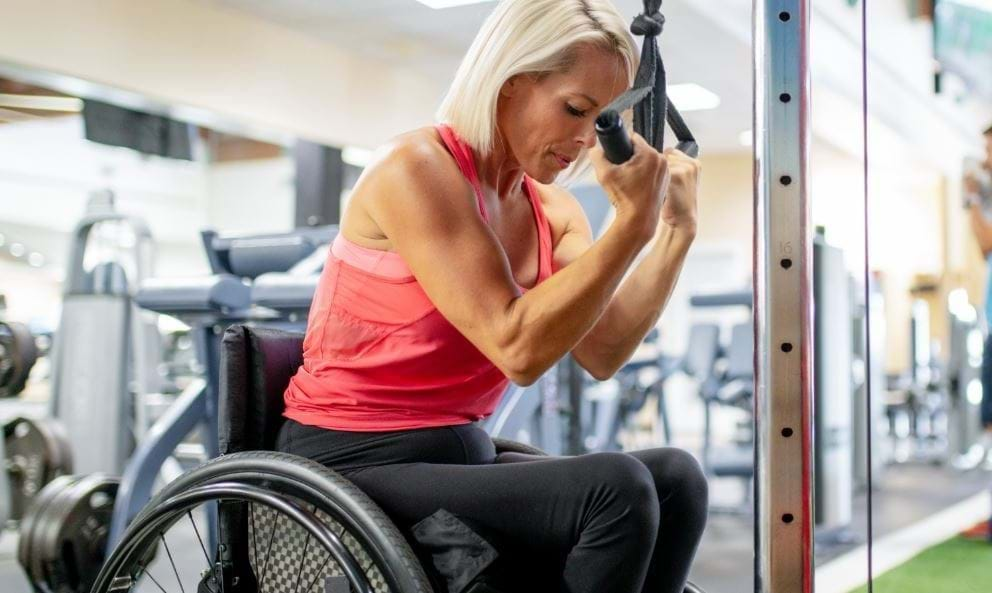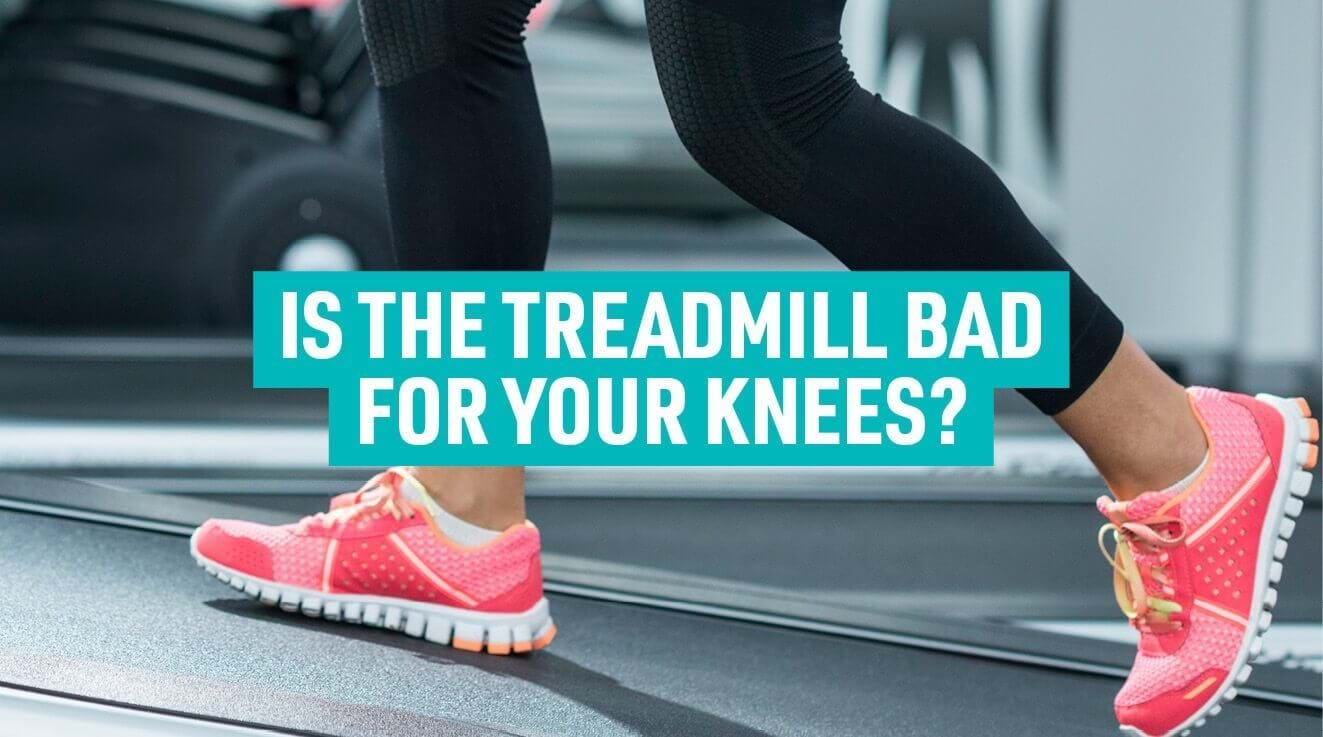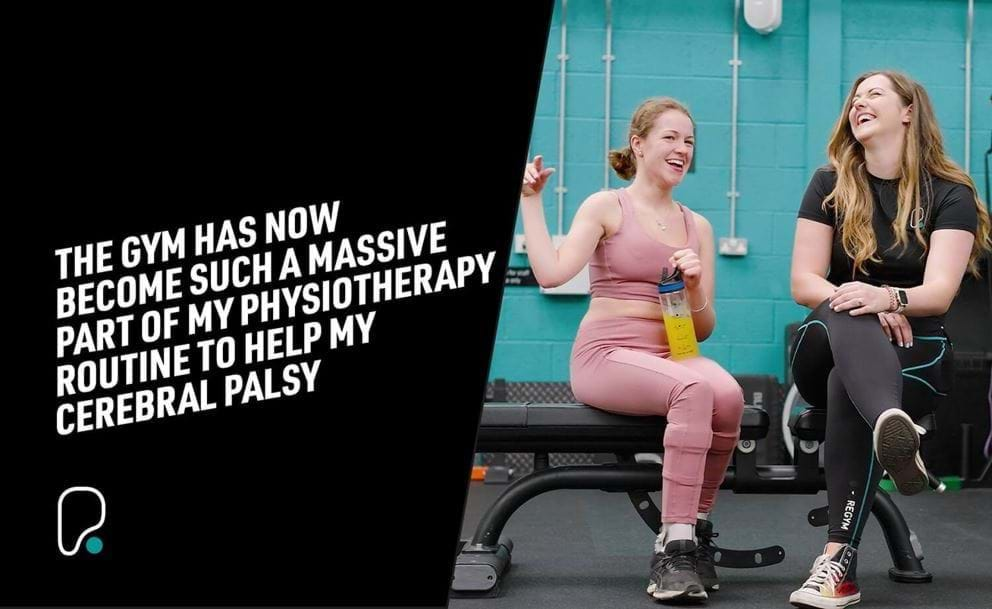The Best Wheelchair Accessible Gym Equipment for Strength and Conditioning

PureGym Personal Trainer and Disability Activist, Rob Ghahremani, specialises in dealing with injury and disability, and is a wheelchair user himself. We asked him for his thoughts and advice on the best core exercises for wheelchair users.
Why is strength and conditioning important for wheelchair users?
Whether you're a wheelchair user or not, strength and conditioning has so many health benefits including:
Improved bone density
Reduced risk of heart and cardiovascular diseases
Reduced risk of injury
Improved mental health
Weight management
Muscle strength and flexibility
For wheelchair users, strength and conditioning also helps to maintain independence, and reduce the energy needed to navigate everyday life.
Life in a wheelchair means that every action requires more thought and planning than our able-bodied counterparts – will there be stairs, are there disabled toilets, is the terrain easy to move around? Everyday tasks also require more effort for those with disabilities. Showering, toileting, getting dressed, even just moving around, requires so much more energy and effort for wheelchair users.
Strength and conditioning improve physical fitness, which can make a massive difference on how quickly and easily everyday tasks can be done. I fell in love with exercise when I realised that the stronger and fitter I was, the quicker and easier all these menial tasks became. Twenty-minute showers turned into ten-minute showers. Transfers became quicker, plus my spasms had less of an impact on them too. I found that I was able to push my own chair up steeper hills and needed less and less help when out and about. I became more independent in every aspect of life, and I regained time to spend doing things that I love.
Strength and conditioning can also help to increase confidence in wheelchair users. For me, the feeling of correctly lifting heavier weights, doing everything for myself, and the aesthetic changes I witnessed all contributed to a belief in myself that I had never had before.
Strength and Conditioning for Wheelchair Users
Being in a wheelchair means we use our muscle groups differently to non-wheelchair users. Rather than use our legs to get around, we rely more heavily on our tricep and shoulders and use at least one of these muscles groups on almost everything we do -- from propelling your chair (if you're a manual wheelchair user) to supporting your bodyweight when transferring in and out of your chair.
A priority therefore needs to be ensuring our upper body 'push' muscles (shoulders, triceps, chest) are as strong and as stable as possible, so that they have the strength and endurance needed for everyday life.
It's important to not just focus on these muscles alone. Constant overuse of your chest, triceps, and shoulders can lead poor posture and rounded shoulders, so building a strong core (if you're able to) and back can minimise and prevent excessive shoulder-rounding and posture deterioration. I've previously shared core strengthening exercises for wheelchair users here.
While you might think that gyms are more suited for able-bodied people, they have a huge range of equipment, both free weights and resistance machines, so there will always be something you can do no matter what your training experience or disability. Training at a gym vs at home allows better progression (which is essential to building muscle), and access to Personal Trainers who can show you how to safely perform exercises if you're not sure how to.
Whatever level of training experience you have, I would always recommend training with a friend - it's beneficial to have someone with you to help with positioning, lifting, and to compete with when training!
Wheelchair Accessible Resistance Machines
Resistance machines are really useful for both beginner and advanced lifters alike. By following a fixed movement pattern, they allow the correct muscles to be worked in a safe and controlled way. For this reason, almost all resistance machines can be used without needing to use your core at all.
At PureGym, we typically use Matrix or Precor resistance machinery that will require you to be able to transfer out of your wheelchair to position yourself onto the machines.
Depending on your transfer ability, some machines will be harder to get onto than others. Bringing a sliding board can help to make these machines more accessible, or if you have a training partner you can always ask them to help.
Resistance machines which can help to strengthen your chest, triceps, and back are:
Seated Tricep Dip
Pec Fly/Rear Delt
Free Weight Exercises
If you're unable to transfer out of your chair, there are plenty of exercises that can be done using dumbbells and barbells from your wheelchair. There is also a range of free weight alternatives to resistance machines that can be done out of your chair too -- it's worth trying different alternatives to see what feels right for you.
Some of these exercises use the core to stabilise the body, so if you're like me and you are unable to use your core/abdominal muscles, you may find that doing some of these exercises are very difficult to do without some form of assistance or adaptation.
Flat Bench Barbell Press
- Set the bar to a weight you're comfortable with. Most bench press racks use a 20kg Olympic barbell.
- Lie on the bench with your head under the barbell and squeeze your shoulder blades together.
- Grip the barbell with your hands slightly wider than shoulder-width apart.
- Push the barbell up to take it off the rack, and then press it towards the ceiling by extending your arms upwards, making sure to keep your wrists straight.
- Inhale while lowering the barbell in a controlled, smooth movement, stopping when it's resting just above the bottom half of your sternum and your triceps are parallel with the floor.
- Pause before driving the barbell back up as you exhale.
It can be tricky holding a barbell whilst laying flat without being able to use your core. You may find that if the barbell goes slightly off centre or if your legs don't stay in position that you may fall of the bench. To avoid this, have your training partner stand over and spot you with one leg either side of your core to add an extra level of security.
Clean and Press
This exercise is typically done standing but can be modified so wheelchair users can do the top half of the exercise.
- Set up a squat rack so the safety guards sit slightly higher than your Rest the barbell in front of you on the guards.
- Place your hands on the bar slightly wider than shoulder-width apart with your palms facing towards you.
- Rotate your elbows and curl the barbell up to shoulder height, then press the bar towards to ceiling by extending your arms upwards.
- Return to the start position.
If you are unable to use your core, ensure to do this exercise with the help of your training partner. Have them stand behind you with their arms over your shoulders and hands on your chest so they can pull you upright to stop you from falling forwards during the exercise.
Skull Crushers
- Lie flat on the bench holding a dumbbell in each hand. The top of your head should be level with the edge of the bench.
- Carefully extend your arms above your shoulders so the weight is above your head.
- Bend your elbows to slowly lower the dumbbells down and behind your shoulders.
- Return to start position and repeat.
If you are unable to use your core, try using a barbell instead of single dumbbells as it's easier to stabilise yourself with a bar than with two dumbbells. If you have a training partner, have them stand over and spot you with one leg either side of your core to add an extra level of security.
See more tricep extension variations here.
Bicep Curls
- Sit tall with your back against your chair support or a bench, holding a dumbbell in each hand. Your arms should be pointing towards the floor and palms facing your body.
- Bend your elbows to bring the dumbbells upwards towards your shoulders, rotating your wrists as you curl so your palms face upward at the top of the movement.
- Slowly lower the dumbbells back to the start position and repeat.
If you are unable to use your core, try only working one arm at a time and use your other hand to hold onto your wheel to keep your balance.
See more bicep curl variations here.
Side Raises
- Grab a dumbbell in each hand and sit with a tall neutral spine, dumbbells hanging at your sides. Lean forward slightly if you can.
- Lift each arm out to the side simultaneously, while keeping a slight bend in your elbows. This should be a slow, controlled movement.
- Hold at the top for a moment before carefully easing back down.
If you are unable to use your core, try only working one arm at a time and use your other hand to hold onto your wheel to keep your balance.
Want more ideas? You can find more seated arm exercises for wheelchair users here.
Cardio for Wheelchair users
Cardio conditioning is just as important as strength training for health, so make sure your workout routine includes exercise which works your cardiovascular system.
Unfortunately, a lot of cardio equipment in gyms are not suitable for wheelchair users -- most gyms are full of treadmills, rowers, and stair-climbers, all of which we can't use. This makes it difficult to improve our cardio in a gym environment, but not impossible -- we just have to get creative!
Some things that you can do if your gym has the equipment are:
Use the hand bike/windjammer
Use the cross-trainer -- position your chair behind the cross trainer and use your arms to move the mechanism
Use the battle ropes
Use the slam balls
Use the rope pull
If you find that your gym doesn’t have the above equipment or you can’t do the exercises listed above, then try a wheelchair sport. I personally love playing and coaching wheelchair basketball and wheelchair tennis – they’re both amazing for getting your fix of cardio whilst also improving your fitness and coordination and can be social too!
How Often Should Wheelchair Users Exercise?
There is no magical amount of exercise you should aim for. Factors that will influence this number include how active you are already, what training experience you have, and what your training goals are.
As a wheelchair user, I ensure that I do four strength training sessions and at least four hours of cardio every week to keep me strong and functional. This may be too much for some people, and not enough for others! If your goal is to build muscle, you should aim to train each muscle group at least twice a week, with a day rest between working the same muscle twice.
For those starting out or just looking to improve their general health, I always recommend that everyone should honour their body with an hour of movement every day. As your fitness increases, you can work this up to more if you want.


